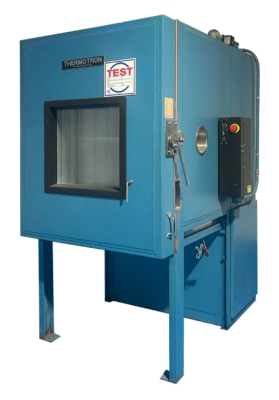In Belement we have a fast temperature chamber in your environmental lab that can handle rapid temperature changes (up to 20°C per minute) for testing materials or products. Such chambers are particularly useful for thermal shock testing, accelerated aging, and performance validation under extreme temperature conditions.
Thermotron F16 High-Speed Chamber (20°C/Min) 
- Operational Volume: 492 liters
- Internal Dimensions: 108 x 65 x 70 cm
- Temperature Range: -73°C to +177°C
- Humidity Range: 20% to 95%
- High-Speed Temperature Range: -54°C to +100°C
- Floating Floor: Designed for shaker integration.
Here are some key considerations and best practices for using this type of chamber effectively:
1. Applications of a Fast Temperature Chamber:
-
-
- Thermal Shock Testing: The ability to rapidly change temperature is ideal for simulating sudden temperature fluctuations. For example, testing how a material or electronic component behaves when transitioning quickly between cold and hot environments (e.g., from -40°C to +80°C).
-
-
-
- Accelerated Aging: Subjecting materials or products to extreme, rapid temperature changes can accelerate the degradation process, helping you estimate how they would age over long periods in real-life conditions.
-
-
-
- Reliability Testing: For components like electronics, automotive parts, or packaging materials, testing their performance under quick thermal cycling can reveal vulnerabilities such as cracking, delamination, or component failure.
-
-
-
- Product Development & Validation: Testing the behavior of prototypes or products under extreme conditions to ensure they will perform correctly under various environmental stresses.
-
2. Key Considerations When Using a Fast Temperature Chamber
-
-
- Temperature Range and Control: Ensure that the chamber can handle the temperature range required for your tests. Fast temperature chambers are often designed to cycle quickly between extreme hot and cold conditions, so you should know the upper and lower limits of the chamber to ensure your tests stay within operational limits.
-
-
-
- Cycle Time & Duration: The rapid temperature change (20°C per minute) allows for short-duration testing that simulates many years of use in a very short period. Make sure that the cycle time (how quickly you change the temperature) and the duration of each temperature stage (e.g., how long the test sample stays at each temperature) are aligned with your test objectives.
-
-
-
- Test Sample Placement: Proper placement of test samples inside the chamber is crucial for uniform temperature exposure. Ensure that the sample is centered in the chamber for even distribution of temperature and that air circulation within the chamber is sufficient to prevent localized temperature discrepancies.
-
-
-
- Monitoring & Data Logging: Use data loggers or temperature sensors inside the chamber to monitor the exact conditions the test sample is exposed to, including:
- Temperature at various points.
- Time spent at each temperature.
- Rate of temperature change. This data is critical for analyzing the impact of the test conditions on your samples.
- Monitoring & Data Logging: Use data loggers or temperature sensors inside the chamber to monitor the exact conditions the test sample is exposed to, including:
-
-
-
- Thermal Gradient and Heat Distribution: Even though the chamber can change temperatures quickly, make sure that the thermal gradient (the difference between the hottest and coldest points inside the chamber) is within acceptable limits for your test. Uneven heat distribution can cause inconsistent test results.
-
-
-
- Condensation Control: Rapid temperature changes can sometimes lead to condensation inside the chamber or on the test samples. This is particularly important for testing electronics or materials that are sensitive to moisture. If condensation is a concern, ensure that the chamber has humidity control features or plan to carry out the test under dry conditions.
-
-
-
- Safety and Precautions: Rapid temperature changes can lead to unexpected stress on the chamber and the test samples. Make sure your team follows proper safety protocols, especially when handling sensitive or fragile materials. Consider setting alarm thresholds for temperature or humidity levels to prevent over-exposure to extreme conditions.
-
3. Testing Protocols
To ensure reproducibility and consistency in your results, it’s essential to define a clear testing protocol. Here are some components you may want to include:
-
-
- Temperature Profile: Determine the temperature ranges you will be testing (e.g., from -40°C to +85°C). Specify how quickly the temperature should change and the duration at each temperature.
-
-
-
- Test Stages: Identify if you will be performing single-stage tests (staying at a constant temperature for a set period) or multi-stage tests (cycling through different temperatures).
-
-
-
- Test Repeatability: Depending on your test goals, it may be necessary to run multiple cycles to assess how the material behaves over several temperature changes.
-
-
-
- Test Sample Conditions: Make sure to document the initial conditions of the sample (e.g., starting temperature, material properties, packaging) to compare with results.
-
4. Types of Tests You Can Perform
-
-
- Thermal Cycling (Temperature Cycling): This involves repeatedly exposing the sample to alternating hot and cold temperatures. For example, a test might involve cycling from 0°C to 70°C every 30 minutes for 100 cycles.
-
-
-
- Thermal Shock (Extreme Temperature Transitions): You can perform tests with rapid temperature changes (e.g., going from -40°C to 80°C in less than a minute) to simulate environmental stress during transportation or use.
-
-
-
- Humidity Exposure with Temperature: If your chamber can also control humidity, you could test the interaction of heat and moisture. For example, testing how high-humidity environments (90% RH) combined with high temperatures affect materials or electronics.
-
-
-
- Component Testing: For example, testing how circuit boards, automotive components, or packaging materialsrespond to rapid thermal cycling can help reveal weaknesses such as solder joint failures, material cracking, or dimensional changes.
-
5. Data Analysis
After conducting the test, it’s important to analyze the data to understand how the materials or products perform under these rapid temperature changes. Some key metrics to look for include:
-
-
- Physical changes: Cracks, warping, or delamination in materials.
- Functional performance: For electronics, checking if the system still functions properly after exposure to extreme conditions.
- Failure Modes: Identifying any patterns of failure, such as component fatigue or corrosion from rapid heating and cooling.
-
6. Common Problems to Watch For
-
-
- Overheating: If the chamber is not cooling quickly enough or heating too slowly, the test conditions could be compromised.
- Condensation: As mentioned earlier, condensation can be a problem when rapidly changing temperatures, especially when transitioning from cold to hot.
- Sample Damage: Some materials or components may not be able to handle the rapid changes and may fail prematurely during testing, so always consider the material properties before conducting tests.
-
Conclusion
Using a fast temperature chamber for testing provides valuable insights into how products and materials will react under extreme, fluctuating conditions. By carefully controlling the temperature rates, monitoring environmental conditions, and analyzing the results, you can assess the reliability and performance of your products under simulated real-world scenarios. Make sure to follow safety protocols and ensure that all data is accurately recorded to gain meaningful insights from the tests.
If you need further help designing specific tests or interpreting data from your fast temperature chamber, feel free to ask us!


